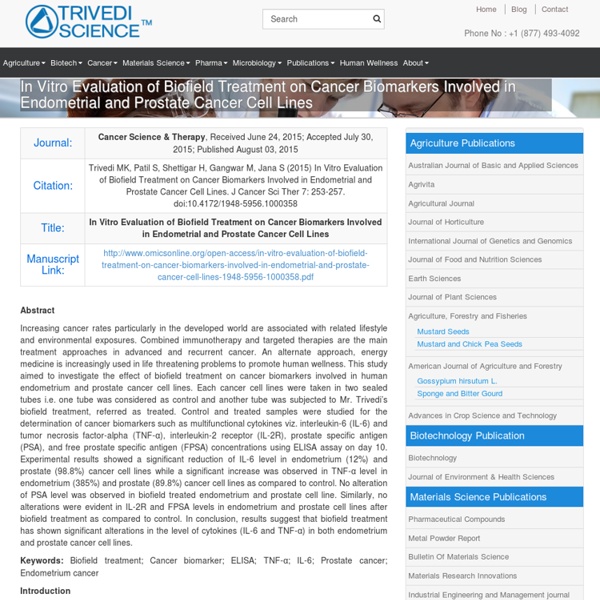An Emerging Global Opportunistic Pathogen
Abstract Stenotrophomonas maltophilia ( S. maltophilia ) is a Gram-negative bacillus, an opportunistic pathogen, particularly among nosocomial infections. Multi-drug resistant strains are associated with very high rate of morbidity and mortality in severely immunocompromised patients. Present study was designed to evaluate the effect of biofield treatment against multidrug resistant S. maltophilia . Clinical sample of S. maltophilia was collected and divided into two groups i.e. control and biofield treated which were analyzed after 10 days with respect to control. The following parameters viz. susceptibility pattern, minimum inhibitory concentration (MIC), biochemical studies and biotype number of both control and treated samples were measured by MicroScan Walk-Away® system.
User:Mahendra Kumar Trivedi
The Trivedi Effect, Henderson, USA Mr. Mahendra TrivediFounder and Chairmen Affiliation: Trivedi Global Inc., 10624 S Eastern Avenue Suite A-969, Henderson, NV 89052, USA Biography Mr.
Effect of Bio Field Treatment on the Physical and Thermal Characteristics of Vanadium Pentoxide Powders
Make the best use of Scientific Research and information from our 700+ peer reviewed, Open Access Journals that operates with the help of 50,000+ Editorial Board Members and esteemed reviewers and 1000+ Scientific associations in Medical,Clinical,Pharmaceutical,Engineering, Technology and Management Fields. Meet Inspiring Speakers and Experts at our 3000+ Global Conferenceseries Events with over 600+ Conferences, 1200+ Symposiums and 1200+ Workshops on Medical, Pharma, Engineering, Science, Technology and Business
"An Effect of Biofield Treatment on Multidrug-resistant Burkholderia ce" by Mahendra Kumar Trivedi
Abstract Burkholderia cepacia (B. cepacia) is an opportunistic, Gram negative pathogen which causes infection mainly in immunocompromised population and associated with high rate of morbidity and mortality in cystic fibrosis patients. Aim of the present study was to analyze the impact of biofield treatment on multidrug resistant B. cepacia.
Characterization of Biofield Energy Treated 3-Chloronitrobenzene: Physical, Thermal, and Spectroscopic Studies
The chloronitrobenzenes are widely used as the intermediates in the production of pharmaceuticals, pesticides and rubber processing chemicals. However, due to their wide applications, they are frequently released into the environment thereby creating hazards. The objective of the study was to use an alternative strategy i.e. biofield energy treatment and analysed its impact on the physical, thermal and spectral properties of 3-chloronitrobenzene (3-CNB). For the study, the 3-CNB sample was taken and divided into two groups, named as control and treated. The analytical techniques used were X-ray diffraction (XRD), thermogravimetric analysis (TGA), differential scanning calorimetry (DSC), UV-Visible (UV-Vis), and Fourier transform infrared (FT-IR) spectroscopy.
Impact of Biofield Treatment on Klebsiella oxytoca
Abstract Klebsiella oxytoca (K. oxytoca) is a Gram-negative microbe generally associated with community and hospitalacquired infections. Due to its clinical significance, we evaluated the effect of biofield treatment on phenotype and biotype characteristics of K. oxytoca (ATCC 43165). The study was performed into three groups i.e. C (control), T1 (treatment, revived); and T2 (treatment, lyophilized).
Biofield Treatment (peteragre) - Spaaze
Read about Growth of Lettuce and Tomato on Peervaluation - Mahendra Kumar Trivedi has published the paper on Australian Journal of Basic and Applied Sciences entitled “Impact of Biofield Treatment on Growth and Yield of Lettuce and Tomato”. Growth of Lettuce and Tomato after Biofield Treatment -
Publication meta - Spectroscopic Characterization of Disulfiram and Nicotinic Acid after Biofield Treatment - Publications
Disulfiram is being used clinically as an aid in chronic alcoholism, while nicotinic acid is one of a B-complex vitamin that has cholesterol lowering activity. The aim of present study was to investigate the impact of biofield treatment on spectral properties of disulfiram and nicotinic acid. The study was performed in two groups i.e., control and treatment of each drug. The treatment groups were received Mr. Trivedi’s biofield treatment.
Impact of Biofield Treatment on Characteristics of Magnesium
Abstract Magnesium (Mg), present in every cell of all living organisms, is an essential nutrient and primarily responsible for catalytic reaction of over 300 enzymes. The aim of present study was to evaluate the effect of biofield treatment on atomic and physical properties of magnesium powder. Magnesium powder was divided into two parts denoted as control and treatment.
Publication meta - Characterization of Biofield Energy Treated 3-Chloronitrobenzene: Physical, Thermal, and Spectroscopic Studies
The chloronitrobenzenes are widely used as the intermediates in the production of pharmaceuticals, pesticides and rubber processing chemicals. However, due to their wide applications, they are frequently released into the environment thereby creating hazards. The objective of the study was to use an alternative strategy i.e. biofield energy treatment and analysed its impact on the physical, thermal and spectral properties of 3-chloronitrobenzene (3-CNB). For the study, the 3-CNB sample was taken and divided into two groups, named as control and treated. The analytical techniques used were X-ray diffraction (XRD), thermogravimetric analysis (TGA), differential scanning calorimetry (DSC), UV-Visible (UV-Vis), and Fourier transform infrared (FT-IR) spectroscopy.
Impact Of Biofield Treatment On Salmonella Paratyphi A
Abstract Enteric fever is a major global problem. Emergence of antimicrobial resistance threatens to render current treatments ineffective.



